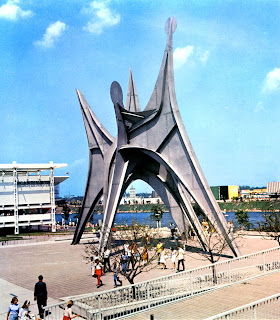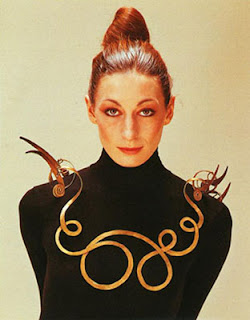Alexander Calder
"How Can Art Be Realized?"
Wednesday, November 30, 2011
Google Doodle
July 22, 2011 on the date of what would have been Calder's 113th birthday; Google honored and celebrated the artist with an interactive doodle inspired by one of his brightly colored "mobiles." The interactive design was featured on the homepage of the Google search engine and reacted to mouse/cursor positioning and interaction making the idea almost as real as one of Calder's own infamous "mobiles."
Death & Legacy
Two months after his death, Calder was awarded the Presidential Medal of Freedom which is the highest civilian honor one could receive in the United States. The award was to be presented by President Gerald Ford on January, 10 1977; but the ceremony was boycotted by the family of Calder. They claimed they were doing so to "make a statement favoring amnesty for Vietnam War draftees."
Since then a foundation has been set up in Calder's name. The foundation runs its own programs, collaborates on exhibitions and publications, and gives advice on matters such as the history, assembly, and restoration of works by Calder. The Foundation has large holdings from Calder family members and other foundation supporters and founders.
There was once plans for a Alexander Calder memorial museum to be built in Philadelphia in his honor, but plans for it have been put on hold for the time being. Museums all over the world hold Calder exihibits and some have whole rooms dedicated to his works such as in the Whitney Museum of American Art in New York and the National Gallery of Art in Washington D.C.
Below is the "Calder Room" at the National Gallery of Art in Washington D.C.:
Since then a foundation has been set up in Calder's name. The foundation runs its own programs, collaborates on exhibitions and publications, and gives advice on matters such as the history, assembly, and restoration of works by Calder. The Foundation has large holdings from Calder family members and other foundation supporters and founders.
There was once plans for a Alexander Calder memorial museum to be built in Philadelphia in his honor, but plans for it have been put on hold for the time being. Museums all over the world hold Calder exihibits and some have whole rooms dedicated to his works such as in the Whitney Museum of American Art in New York and the National Gallery of Art in Washington D.C.
Below is the "Calder Room" at the National Gallery of Art in Washington D.C.:
Tuesday, November 29, 2011
Later Years
Towards the final years of his life, Calder devoted most of his artwork on commissions he received from the public and other beneficiaries. They were mostly monumental and metal in design; such as his piece "Teodelpio" which he designed for a town in Italy and "Man" a sculpture he built for the 1967 Montreal Olympics exposition.
"Man"
"Teodelpio"
Aula Magna
The "Aula Magna" is a huge brightly colored multi sculptured piece that scatters across an acoustic ceiling. It was designed in 1953 by Calder for the auditorium at Universidad Central de Venezuela. It was created in what is categorized as Calder's more Prolific years.
Lobster Trap and Fish Tail
Created in 1939, the "Lobster Trap and Fish Tail" was installed in the main stairwell of the new Museum of Modern Art building in New York. It consists of painted wire and sheet aluminum and is about 8' 6" (260 cm) x 9' 6" (290 cm) in diameter.
International Mobile
In 1943, the Museum of Modern Art hosted a well-received Calder retrospective, it was curated by James Johnson Sweeney and Marcel Duchamp.
Calder was one of 250 sculptors who was exhibited in the 3rd Sculpture International held at the Philadelphia Museum of Art in 1949. "International Mobile" was the centerpiece of the exhibition. The picture above is an image of Alexander Calder installing the "International Mobile."
Calder was one of 250 sculptors who was exhibited in the 3rd Sculpture International held at the Philadelphia Museum of Art in 1949. "International Mobile" was the centerpiece of the exhibition. The picture above is an image of Alexander Calder installing the "International Mobile."
Monday, November 21, 2011
Calder Jewelry
Over the course of his life Alexander Calder had created around 1800 pieces of jewelry. Most of them were created from scraps of metal like brass and steal and also would contain pieces of ceramic or wood to accent them. What made his jewelry even more interesting was the fact that Calder rarely used solder; when he needed to join strips of metal, he linked them with loops, bound them with snippets of wire or fashioned rivets.
In 1942 at the oppening of her New York gallery, Peggy Guggeheim wore 1 earing from Calder's collection and another from Yves Tanguy's to show her equal loyalty towards both abstract and surrealist art. Other people who were presented with Calder's jewlery were close friends of his and people within the art community he respected; such as Georgia O'Keeffe, Alexina Duchamp (wife of Marcel Duchamp), Jeanne Ruca (wife of filmmaker Luis Bunuel), and Bella Rosenfeld (wife of Marc Chagall).
Subscribe to:
Comments (Atom)








